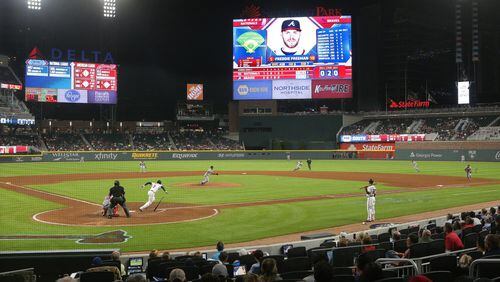Title this one Freddie Freeman vs. the Freak Defense: Or How I Learned to Stop Worrying and Love the Shift.
As the Braves’ first baseman goes about his torrid April, hitting over .400, he as much as any player in the majors is mocking the fad of tilting the infield — utilizing three gloves on one side of the diamond — to mess with a pull-hitter’s Zen.
“Put four guys on the right side of the field, I don’t care,” Freeman said. “It’s on me to beat them. They are trying to beat me in a way. And I got to beat them back.”
And then he’ll express his affection. “I love it because I get more hits out of the shift than it has taken away from me.”
Shift happens.
It happens with increasing frequency throughout baseball.
It happens often to the left-handed Freeman — dictated by game situation. For instance, his first at-bat against Washington on Tuesday. With the bases empty, the Nationals deployed second baseman Daniel Murphy on the grass in shallow right field, shortstop Wilmer Difo to the right of second base and put third baseman Anthony Rendon on an island all by himself on the left side. That’s the exaggerated shift, the capital “S” Shift.
(Oh, and Freeman singled up the middle).
The Braves would do likewise against the Nats’ Bryce Harper, painfully to no effect. Everyone shifts. And as both Freeman and Harper attested last week, there is no defense against an elite hitter on a tear. You think you’re looking smart with some new-age alignment? But you’re just fooling yourself.
“He’s gotten a number of hits already (that) if (defenses) had been straight up, or shifted a little bit rather than over-shifted, they’d probably been outs,” Braves manager Brian Snitker said.
Regardless of where Freeman puts the ball in play, “It’s tough to catch when he hits the ball hard,” smiled his hitting coach, Kevin Seitzer.
Rather than show frustration with the stacked defense that he has faced ever more frequently over the years, Freeman chooses to heap scorn upon it. And then thank it for hits he otherwise would have been unable to claim.
Freeman is at heart old-school. A wool-uniform-and-stirrup soul playing in a miracle-fiber age. As such, the shift slightly insults his sensibilities.
“I don’t understand the shift, especially the over-shift,” he said. “I understand that I’m hardly ever going to hit a ground ball right at the third baseman. I get that (and the need for a slight shift to the right). The one where there’s three guys on the right side of the field? That makes zero sense to me.
“I think you give up nine hits out of 10. And that one hit you take away, that’s the only one you remember, so you think it worked. This game has been played the same way for 130 years and all of a sudden you’re going to try to re-invent the wheel, shifting guys? Now I’ve heard them talking about four guys in the outfield — please do that. I hope they do it against us. We’ll gladly take those hits.”
Freeman has been particularly difficult to defend this month. As of mid-week, he was hitting a majors-leading .440. As to the shift’s intent to limit his power, Freeman had six home runs through 14 games, which projects to oh, only 69 for a full season (not a prediction, just a projection).
And there’s no shift against the home run. Opponents can’t station outfielders up near the Chop House, not yet, anyway.
Numbers, of course, paint Freeman as prone to pull — of his 22 hits entering Wednesday, 11 were to right field, seven to center and four to left. Everyone knows that. Just as everyone knows that when he’s going like this, Freeman is capable of handling a bat like it’s a laser pointer.
Where numbers seem to fail to fully explain why teams employ the shift so determinedly against Freeman, amateur psychology fills in the gaps.
“(Phillies coach) Larry Bowa told me they don’t shift because I pull the ball so much. They shift to get in my head. To try to get me to hit a single to left field instead of trying to get an extra-base hit to right field, or turning on something.”
He’s not averse to playing mind games, too. When Freeman said stuff like this, he’s obviously spreading kernels of doubt in hopes one sprouts in the opposite dugout: “I don’t think I’ve hit a ball yet that would have been caught (only) because the shift was there. Every single ball that I’ve hit would have been caught by a normal defense.”
And in case no one got the message, he’ll add: “As long as they’re going to keep doing it, I think we’re going to keep getting more hits out of it.”
When the Marlins began employing the shift against Freeman just this season, he made sure to thank their first-base coach after collecting his first hit off it. “He just laughed,” Freeman said.
If any opponent cares to watch Freeman hit pregame to gain intel, he’ll remind them that he is anything but a pull-for-power robot. Hitting is more than a primitive reflex with him. So, this is what they’ll see if they care to spy on batting practice: “His whole approach and mindset is to hit line drives the other way, and he takes that into the game,” Seitzer said. “But his hands are so quick he pulls a ton on balls.”
When a team employs this defense, it’s telling the hitter: Look at all this empty real estate, we don’t think you can put it to any good use. But if you’d like to try, please do. We invite you to become a singles hitter.
The key for Freeman, especially when on tear like now, is to not sucker for the temptation. “As long as he’s driving the ball all over the ballpark, you don’t want to try to change that, to just try to make him push balls the other way. Because that would really play into what the opposition wants,” Seitzer said.
Teams wouldn’t use the shift were it a statistical failure. They continually are met by numbers like this from 2016, courtesy of Baseball Info Solutions: Players hit .266 when hitting a ground ball or a short line drive against a conventional infield alignment, .272 when hitting against a partly shifted infield. But against over-shifted infields, they hit .229. It was estimated that teams saved 359 runs thanks to the shift.
Hence an explosion in the use of the shift, from 2,400 times throughout the majors in 2010 (based on balls put in play) to more than 28,000 times last year, according to Baseball Info Solutions.
As new baseball commissioner Rob Manfred came to office in 2015, he brought with him the idea of passing rules against the more radical shifts that overloaded one side of the field. Anything to incite offense.
That idea has gained little traction, and one of the shift’s main targets says no rule change is necessary.
“Too many rules are coming into play already. Leave the game how it is and if people want to do something different, then that’s on us to beat it,” Freeman said. “They’re giving us a hit to the left side — then take the hit.”
Freeman believes a new breed of versatile hitter will cut into the effectiveness of the over-shift and give teams pause before they use it so routinely. Maybe the alignment can be beaten into submission, he reasons. “I think we’re going back to the way it was, trying to hit the ball all over the place,” he said.
His hitting coach isn’t so sure. Seitzer knows how stubborn coaches can be once they latch onto an idea.
The battle continues. So, who’s winning in Freddie Freeman vs. the shift?
“Freddie Freeman,” Freeman said.
Then he smiled. “So far I am. When I line out to right field four times in a row, I’ll talk differently.”
About the Author







